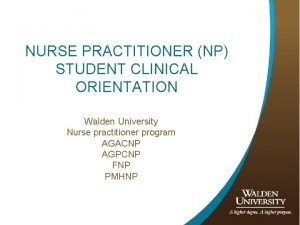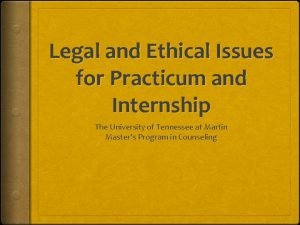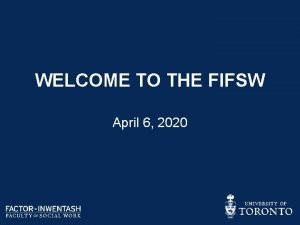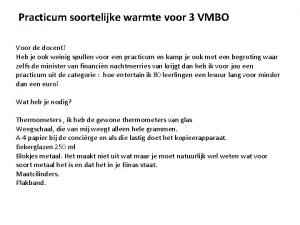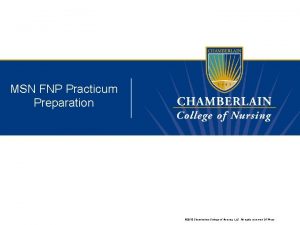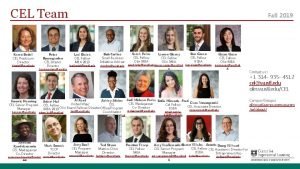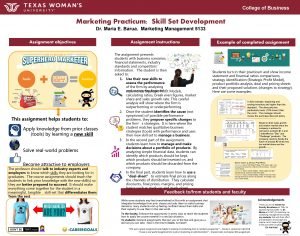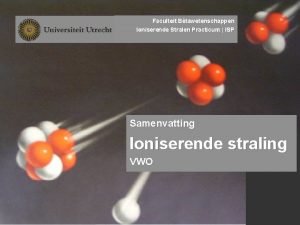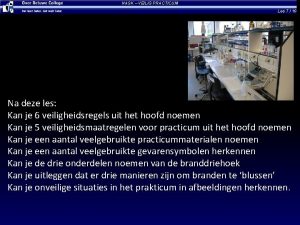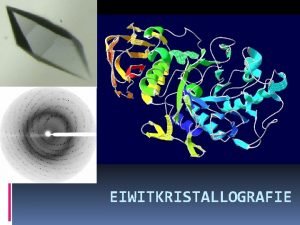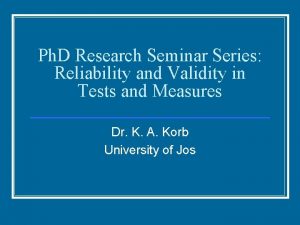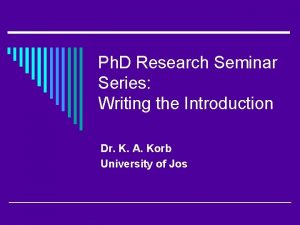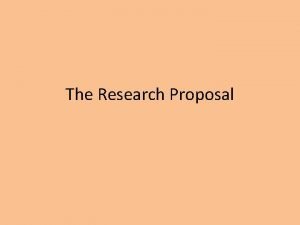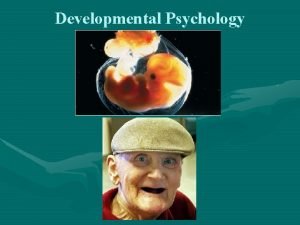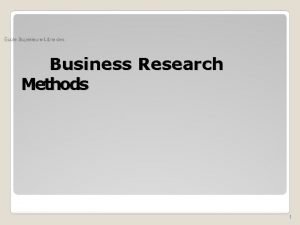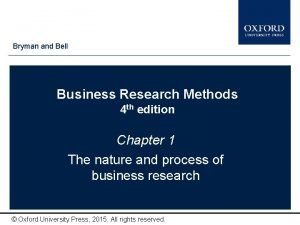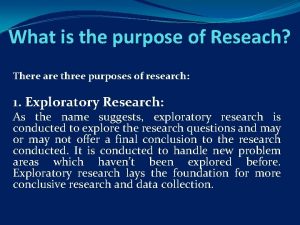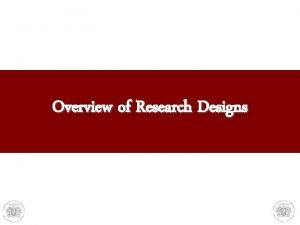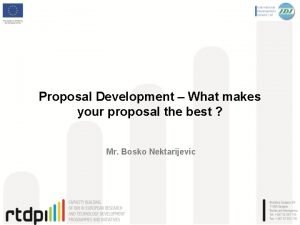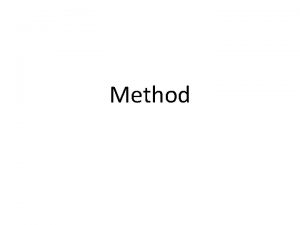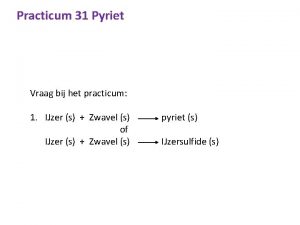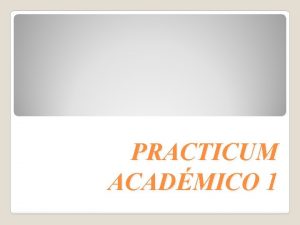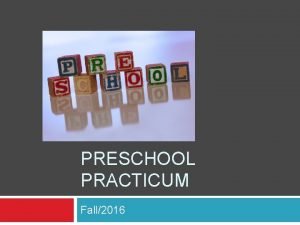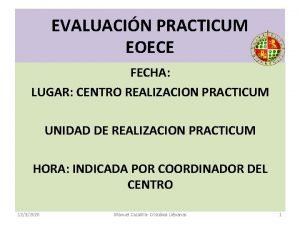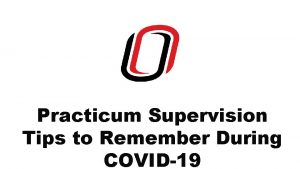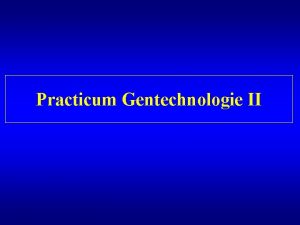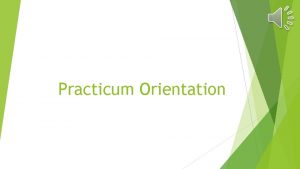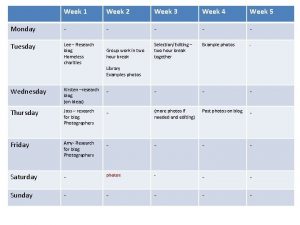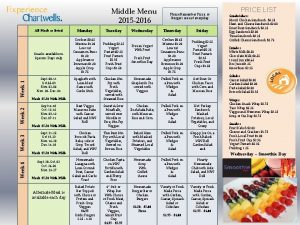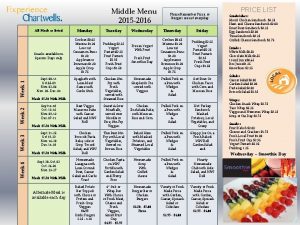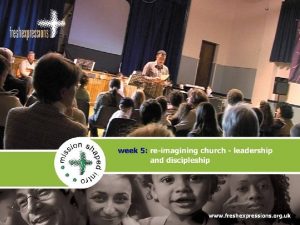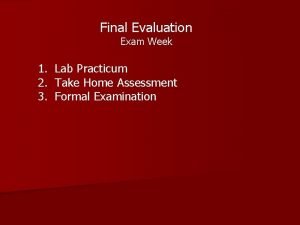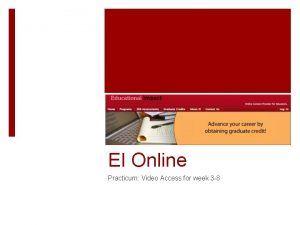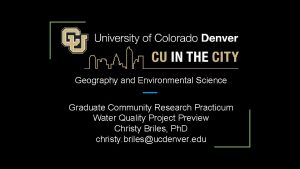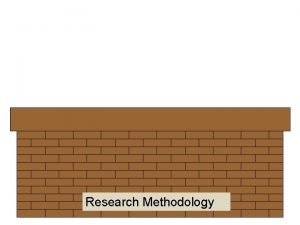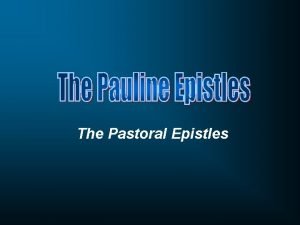RESEARCH SEMINAR Week 2 3 This seminar practicum


![Course Agenda PART I: FOUNDATIONS OF RESEARCH [weeks 1 -8] • Each week we Course Agenda PART I: FOUNDATIONS OF RESEARCH [weeks 1 -8] • Each week we](https://slidetodoc.com/presentation_image/d6218dd1f0f86e0e1fd44def06652ec9/image-3.jpg)
































- Slides: 35

RESEARCH SEMINAR Week 2 & 3 This seminar (practicum = practice doing something) will demonstrate how qualitative research is done based upon Western research practices. By the end of the semester you will complete a short data collection and analysis (in teams of 3) based upon a research project we will do in class. This is a beginning research course aimed at demonstrating broad information of qualitative research methods. Dr. Elizabeth Tuleja Mendoza College of Business University of Notre Dame etuleja@nd. edu

Our Agenda Week 2 Reading/Lesson/Activity 11 Sept Critical reading – examine the components of a research article Go over syllabus to get the big picture Topic: Components of a Research Paper READ: PART I: Abstract and Parts 1, 2, 3, Tuleja, 2017: Constructing Image-Based Culture Definitions Using Metaphors: Impact of a Cross-Cultural Immersive Experience Homework: Prepare questions based upon these first few sections of the article and be prepared to discuss in class.
![Course Agenda PART I FOUNDATIONS OF RESEARCH weeks 1 8 Each week we Course Agenda PART I: FOUNDATIONS OF RESEARCH [weeks 1 -8] • Each week we](https://slidetodoc.com/presentation_image/d6218dd1f0f86e0e1fd44def06652ec9/image-3.jpg)
Course Agenda PART I: FOUNDATIONS OF RESEARCH [weeks 1 -8] • Each week we will spend time doing critical readings of journal articles. We will spend two-weeks examining one article based upon the objectives of the class period (eg. Organizing a proposal, literature review, methodology, etc. ). PART II: DATA COLLECTION AND ANALYSIS [weeks 9 -11] • During this part, we will discuss how to collect data and how to analyze it using qualitative methods. Then you will go out and collect TWO data sets (DATA I IMAGES and DATA II Images). PART III: PRESENTATION [weeks 12 -15] • You will analyze as a team and then give a short presentation based upon each data set (A & B). This will help us see the emerging themes. PART IV: FOUNDATIONS OF RESEARCH [weeks 16 -18] • To conclude our course, each team will take a set of questions (you will be provided with questions) and then will write a short summary/analysis.






https: //ori. hhs. gov/content/module-1 -introduction-what-research

The Scientific Method consists of observing the world around you and creating a hypothesis about relationships in the world. • A hypothesis is an informed and educated prediction or explanation about something. • Part of the research process involves testing the hypothesis, and then examining the results of these tests as they relate to both the hypothesis and the world around you. • When a researcher forms a hypothesis, this acts like a map through the research study. • It tells the researcher which factors are important to study and how they might be related to each other or caused by a manipulation that the researcher introduces (e. g. a program, treatment or change in the environment). • With this map, the researcher can interpret the information he/she collects and can make sound conclusions about the results. https: //ori. hhs. gov/content/module-1 -introduction-what-research

Research Design https: //ori. hhs. gov/content/module-1 -introduction-what-research


Break 13

Discussion In Small Groups • Answer the following prompt: I think research is… • Write down everyone’s response – there are no right or In Large Group • Write your list on the white board. • We will discuss as a class. • What are themes that emerged? • What might NOT be research?

Our “Findings” Research is… • • • Process Ideas Checking ideas Creating new ideas Variables Hypotheses Validity Reliability Learning Scientific testing • • • Data Interviews Observation Analyzing Comparing Results Testing Clarifying Searching Leads to more research • Learning • Creating

Next Week 3 18 Sept Reading/Lesson/Activity Close reading – examine the components of a research article Topic: Understanding a theoretical model READ: PART II: Tuleja, 2017: Constructing Image-Based Culture Definitions Using Metaphors: Impact of a Cross-Cultural Immersive Experience Homework: Follow instructions and bring your Image of Culture to class. Homework: Prepare questions about UNDERSTANDING A THEORETICAL MODEL and be prepared to discuss in class.

WEEK 3 • First, we will explore the meaning of metaphor. • Second, we will discuss the entire article (we need to “catch up” from last week).

百闻不如一见 Metaphors are an important part of understanding culture. The saying in English, “a picture is worth a thousand words” is used in all cultures. In Chinese, 百闻不如一见 Hearing a hundred times is not as good as seeing once… The actual words/characters are different, yet they convey the same meaning. Often we can best describe something through an image or a picture, which helps us take abstract ideas and make them tangible and concrete.

Image of Chinese Culture These are the instructions you will be giving to classmates. Create your own image of culture and bring to class. • Find an image on the Internet that depicts your understanding of the concept of Chinese culture. (If you have a picture of your own then use that. ) Don’t look up any definitions – just go with what you think. Copy and paste it, along with its URL to a PPT slide. • On the slide write 100 words or less (you may also include Chinese characters if this helps with your comprehension and expression) that describes your image of culture. • In the Notes-Section of the PPT, write your name, age, gender, what city/province you come from, major area of study, and whether you are an undergraduate or graduate student. • We. Chat or E-Mail your image to your friend who is doing the research study. Your identity is private – we only ask for this information for coding purposes.

Cultural Metaphor • An innovative method for understanding the cultural mindset of a nation = looking for cultural cues. • Identifies some phenomenon, activity, or institution of a nation’s culture that all or most of its members consider to be very important and with which they identify cognitively and/or emotionally. • This is supported by a research method that analyzes these phenomena/activities/institutions through the ‘constant comparison method’ (Strauss & Corbin) and use a variety people from that culture to confirm or disconfirm the findings. • The characteristics of the metaphor then become the basis for describing and understanding the essential features of the society. 20

Cultural Metaphor • Metaphors are not stereotypes – rather, they rely on the features of one critical phenomenon/activity in a society to describe the entire society. Ø Americans love football and are passionate about it. • The characteristics of this metaphor then become the basis for describing and understanding the essential features of the society. Ø Speed, constant movement, high degree of specialization, consistent aggressiveness, and intense competition sum up the nature of American Football. 21

Cultural Metaphor: American Football These are Hofstede Cultural Dimension findings regarding the phenomenon/ activity of American Football (we’ll discuss Hofstede in another session). • • Aggressive individualism Low uncertainty avoidance (willing to take risks) High masculinity (aggressive and material orientation to life) Low power distance (informality) What practical implications would this cultural mindset have in doing business globally? http: //geert-hofstede. com/ Speed, strategy, constant movement, high degree of specialization, consistent aggressiveness, intense competition… 22

Some Other Metaphors French Wine: French people often view their culture in 4 ways: • PURENESS: environment from which it is developed • CLASSIFICATION: no impostors – wine develops its final personality, blend and balance. It is classified in excruciating detail. • COMPOSITION: it is an extraordinary, intricate, and inconstant complex of different ingredients, and so are the French (ancestry, region, social influences). • SUITABILITY: most meaningful occasions of a French person’s life center on food and drink. Certain wines ‘marry’ certain foods, etc. It must be drunk properly. Argentine Tango: PASSION, DETERMINATION, IMPROVISATION, • Music, kinetics of the dance, lyrics, roles of men/women in the dance, history of the dance via immigration from Europe to South American in early 1900 s The purpose of introducing cultural metaphors demonstrates how all of us – no matter from what culture/s – use symbols to convey our deepest held meanings (based upon our values and beliefs). We are most often unaware of these symbols.

Cultural Metaphor • Of course, not all members of a society adhere to the behavioral patterns suggested by the metaphor. • So, we can use phrases as “Some Germans…” “Many Italians…” “The Chinese may tend to…” • While the metaphor itself cannot encompass all of the reality that is found within each society, it is a good starting point for understanding and interacting effectively with it. 24

Metaphors Are Generalizations

COMPONENTS OF A RESEARCH PROPOSAL Research Title – what is its significance? Does it match the purpose of the article? 1. Abstract 2. Introduction 3. Literature Review 4. Methods 5. Analysis 6. Discussion 7. Conclusion 8. References 9. Appendix


Research Title – what is its significance? Does it match the purpose of the article? 1. Abstract 2. Introduction 3. Literature Review 4. Methods 5. Analysis 6. Discussion 7. Conclusion 8. References 9. Appendix




Questions for Discussion in Small Groups (Part 1) • What are the components of the FIRST part of this paper? (parts 14. 2. 5) • What are some of your questions based upon these sections of the article? • What is the significance of the title? • What does the abstract tell us? What do you notice? • What do you learn from the Introduction? • Where does the literature start and stop? What did you learn from reading it? Why is it here? Research Title – what is its significance? Does it match the purpose of the article? 1. Abstract 2. Introduction 3. Literature Review 4. Methods 5. Findings 6. Discussion (Analysis) 7. Limitations 8. Conclusion 9. References 10. Appendix Discuss in your small group and then we will discuss as a class.

Break 33

Questions for Discussion in Small Groups (Part 2) • What are the components of the SECOND part of this paper? (parts 5 -9) • What are some of your questions based upon these sections of the article? • What is the general definition of methodology? What are the specific methods used in this article? • What is the purpose of the FINDINGS section? • What is the purpose of the DISCUSSION section? • Why have a limitations section? • Why is the conclusion so short? Research Title – what is its significance? Does it match the purpose of the article? 1. Abstract 2. Introduction 3. Literature Review 4. Methods 5. Findings 6. Discussion (Analysis) 7. Limitations 8. Conclusion 9. References 10. Appendix Discuss in your small group and then we will discuss as a class.

For next week: • Critical reading – examine the components of our 2 nd research article • Topic: Structuring a research paper (how to create a working outline) • READ: PART I: Tuleja, 2014, Developing Cultural Intelligence for Global Leadership Through Mindfulness
 Week by week plans for documenting children's development
Week by week plans for documenting children's development Walden university nurse practitioner
Walden university nurse practitioner Ethical and legal issues involved in practicum
Ethical and legal issues involved in practicum Pas fifsw
Pas fifsw Practicum soortelijke warmte
Practicum soortelijke warmte Chamberlain practicum coordinator
Chamberlain practicum coordinator Cel practicum
Cel practicum Marketing practicum
Marketing practicum Hefa practicum
Hefa practicum K vangst vervalvergelijking
K vangst vervalvergelijking Veilig practicum
Veilig practicum Amylase practicum
Amylase practicum Reliability in research example
Reliability in research example Operational definition of independent variable
Operational definition of independent variable Research report vs research proposal
Research report vs research proposal Methodology vs research design
Methodology vs research design Research design qualitative
Research design qualitative Distinguish between exploratory and conclusive research
Distinguish between exploratory and conclusive research Define pure research
Define pure research Theoretical background example
Theoretical background example Contrast applied research and basic research
Contrast applied research and basic research Sources of a research problem
Sources of a research problem Research instrument in experimental research
Research instrument in experimental research Longitudinal research and cross sectional research
Longitudinal research and cross sectional research Causal-comparative research
Causal-comparative research Chapter 3 research respondents
Chapter 3 research respondents Example of applied research
Example of applied research Basic research vs applied research
Basic research vs applied research Purpose of reseach
Purpose of reseach Qualitative vs quantitative research
Qualitative vs quantitative research What is inquiry in practical research 2
What is inquiry in practical research 2 Characteristics of descriptive research
Characteristics of descriptive research Exploratory descriptive and causal research
Exploratory descriptive and causal research General objective in research example
General objective in research example Research instrument in experimental research
Research instrument in experimental research Qualitative approach
Qualitative approach

